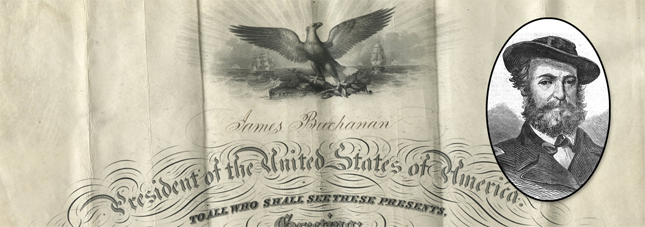
On December 27, 1858 President James Buchanan signed the military commission of William David Porter appointing him Commander in the Navy. Porter was the third brother of a famous naval family. His father, Commodore David Porter, gained fame as captain of the U.S.S. Constitution and later the U.S.S. Essex during the War of 1812. His more famous younger brother, David Dixon Porter, was an admiral during the Civil War and later superintendent of the U.S. Naval Academy. His adopted brother, David Farragut, also rose to the rank of admiral.
William shipped out at 12 years of age on the U.S.S. Franklin, served as lighthouse inspector, and later as ordnance officer at the Washington Navy Yard. He helped develop explosive shells and, from the mid-1840s through 1855, outfitted steamers and commanded supply vessels. He retired in 1855, but at the end of 1858, President James Buchanan promoted him with this commission to commander of the sloop-of-war St. Mary’s in the Pacific.
At the outset of the Civil War, he was reassigned to assist Andrew Foote in creating the Western Flotilla to control the Mississippi River. Porter patrolled the river and engaged Confederate gunboats aboard the U.S.S. Essex, named after his father’s vessel. He was injured when the Essex’s boilers were hit during the attack on Fort Henry, Tennessee, on February 6, 1862. He supervised the vessel’s reconstruction, as well as the construction of Union ironclads, and eventually rejoined the Western Flotilla. In July 1862, he engaged the ironclad C.S.S. Arkansas and narrowly escaped capture after running aground. A month later, the Essex succeeded in destroying the Arkansas. Porter then participated in the bombardment of Natchez, Mississippi, in September 1862. Returning to New Orleans, he was promoted to the rank of commodore and reassigned to New York, where he died in May 1864.
See this beautifully engraved vellum document, signed 154 years ago today . . .




